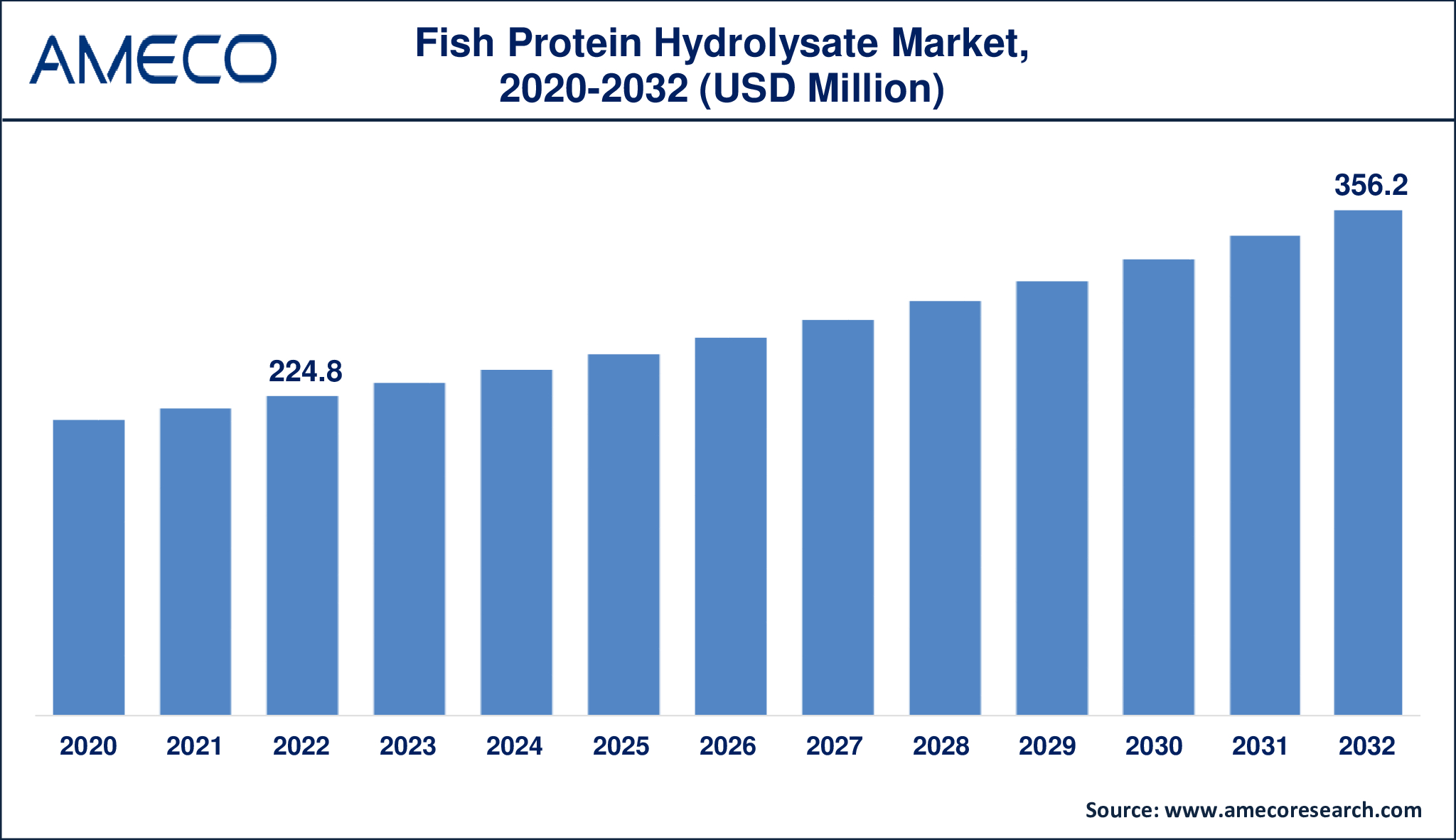Market overview:
The global fish protein hydrolysate (FPH) market, valued at USD 224.8 million in 2022, is projected to reach USD 356.2 million by 2032, growing at a compound annual growth rate (CAGR) of 4.8% from 2023 to 2032. FPH, a bioactive substance produced by enzymatic hydrolysis of fish proteins, offers a rich source of essential amino acids, peptides, vitamins, and minerals. Its increasing applications in sectors such as nutraceuticals, cosmetics, animal feed, and pet food are driving market expansion.
Click here to get a Sample report copy@ https://www.amecoresearch.com/sample/277016
Market Growth Drivers
Rising Demand for Nutraceuticals and Functional Foods
FPH is being widely adopted in the nutraceuticals and functional foods market due to its nutritional benefits. Its bioavailability makes it highly attractive in dietary supplements, sports nutrition products, and food fortification applications. With growing consumer awareness around health and wellness, the demand for FPH-based nutraceuticals is expected to surge.
Animal Feed and Pet Food Applications
The animal feed and pet food industries are incorporating FPH due to its digestibility and high protein content. FPH supports muscle growth, improves metabolism, and enhances immune responses in animals, making it an ideal ingredient for livestock and pets. Asia-Pacific is a key region for this application, predicted to achieve a CAGR of 5.8% by 2032 .
Sustainability and Circular Economy Practices
Fish protein hydrolysate is often produced from fish processing waste, contributing to sustainability and waste reduction. This aligns with the global trend toward a circular economy, where waste materials are reused in the production process. Increasing regulations around sustainable practices and eco-friendly products will further boost the adoption of FPH across various industries.
Future Prospects
The market outlook for fish protein hydrolysate remains highly positive, driven by innovations in the enzymatic hydrolysis process that increase product efficiency and scalability. As research into the bioactive properties of FPH continues, its applications will expand beyond its current uses.
Pharmaceuticals: The pharmaceutical industry is set to explore FPH for its potential in drug formulations aimed at enhancing immune function, wound healing, and anti-inflammatory effects.
Cosmetics: FPH’s collagen-boosting properties and anti-aging benefits make it a promising ingredient in skincare and personal care products.
Aquaculture: As the aquaculture industry continues to expand, FPH will likely play an essential role in enhancing fish growth and improving the sustainability of fish farming operations.
Challenges
Supply Chain Complexity: One of the significant challenges for FPH producers is securing a consistent supply of raw materials, particularly fish waste, as demand increases.
High Production Costs: Enzymatic hydrolysis is a complex and costly process, and maintaining profitability while scaling production will be critical for market participants.
Regulatory Hurdles: Given the diverse applications of FPH across food, feed, and pharmaceuticals, navigating different regulatory frameworks across regions can be challenging.
Key Market Strategies
Collaborations and Partnerships
Leading companies are forming strategic partnerships with suppliers, aquaculture companies, and food manufacturers to strengthen their market position and ensure a steady supply of raw materials. By expanding their sourcing networks, companies can reduce supply chain risks and improve sustainability.
Product Development and Innovation
Companies are heavily investing in research and development (R&D) to create new FPH formulations that target specific applications. Developing tailor-made FPH solutions for pharmaceuticals, pet food, and cosmetics will help players differentiate their offerings.
Geographic Expansion
The demand for FPH is growing rapidly in regions like Asia-Pacific, due to rising awareness of the benefits of fish protein hydrolysate and its growing application in animal feed. Companies are expected to increase their focus on expanding their market presence in these high-growth regions.
To Check Toc: https://www.amecoresearch.com/fish-protein-hydrolysate-market/toc/277016
Conclusion
The global fish protein hydrolysate market is on a steady growth trajectory, driven by increasing demand for its bioactive properties in various industries, including nutraceuticals, animal feed, pharmaceuticals, and cosmetics. With sustainability becoming a critical concern, FPH’s role in reducing waste and promoting eco-friendly practices positions it as a key player in the future of food and health.
MARKET SEGMENTATION:
Fish Protein Hydrolysate Market By Source
- Anchovy
- Tilapia
- Tuna
- Sardine
- Atlantic Salmon
- Crustacean
- Codfish
- Others
Fish Protein Hydrolysate Market By Form
- Powder
- Paste
- Liquid
- Others
Fish Protein Hydrolysate Market By Technology
- Acid Hydrolysis
- Enzymatic Hydrolysis
- Autolytic Hydrolysis
Fish Protein Hydrolysate Market By Application
- Animal Feed
- Food
- Cosmetics
- Pharmaceutical
- Agriculture
CUSTOMIZED REQUIREMENTS? NEED ANY HELP? PLEASE EMAIL US @ sales@amecoresearch.com
To Purchase this Premium Report@ https://www.amecoresearch.com/buy/277016
About Ameco Research:
The complete information about our alliance publishers and the business verticals they cater to helps us in appropriately responding to our client requirements and identifying the potential opportunities in the market and suggest the research that can best suit client’s requirement. Our comprehensive list of research reports boasts a complete collection of database casing almost every market category and sub-category.
Browse For More Related Reports:
The global market for Complete Nutrition Products was worth US$ 3.5 Billion in 2020, and it is expected to grow at a CAGR of 6% from 2021 to 2028.
The Global Vegan Supplements Market size accounted for US$ 9,219 Million in 2021 and is anticipated to reach US$ 16,757 Million by 2030 with a CAGR of 7% from 2022 to 2030.
The Global Lignans Market Size was valued at USD 410.8 Million in 2022 and is anticipated to reach USD 811.8 Million by 2032 with a CAGR of 7.1% from 2023 to 2032.
For Latest Update Follow Us on Twitter and, LinkedIn
Contact Us:
Mr. Richard Johnson
Ameco Research
India: +918983225533
E-mail: sales@amecoresearch.com
